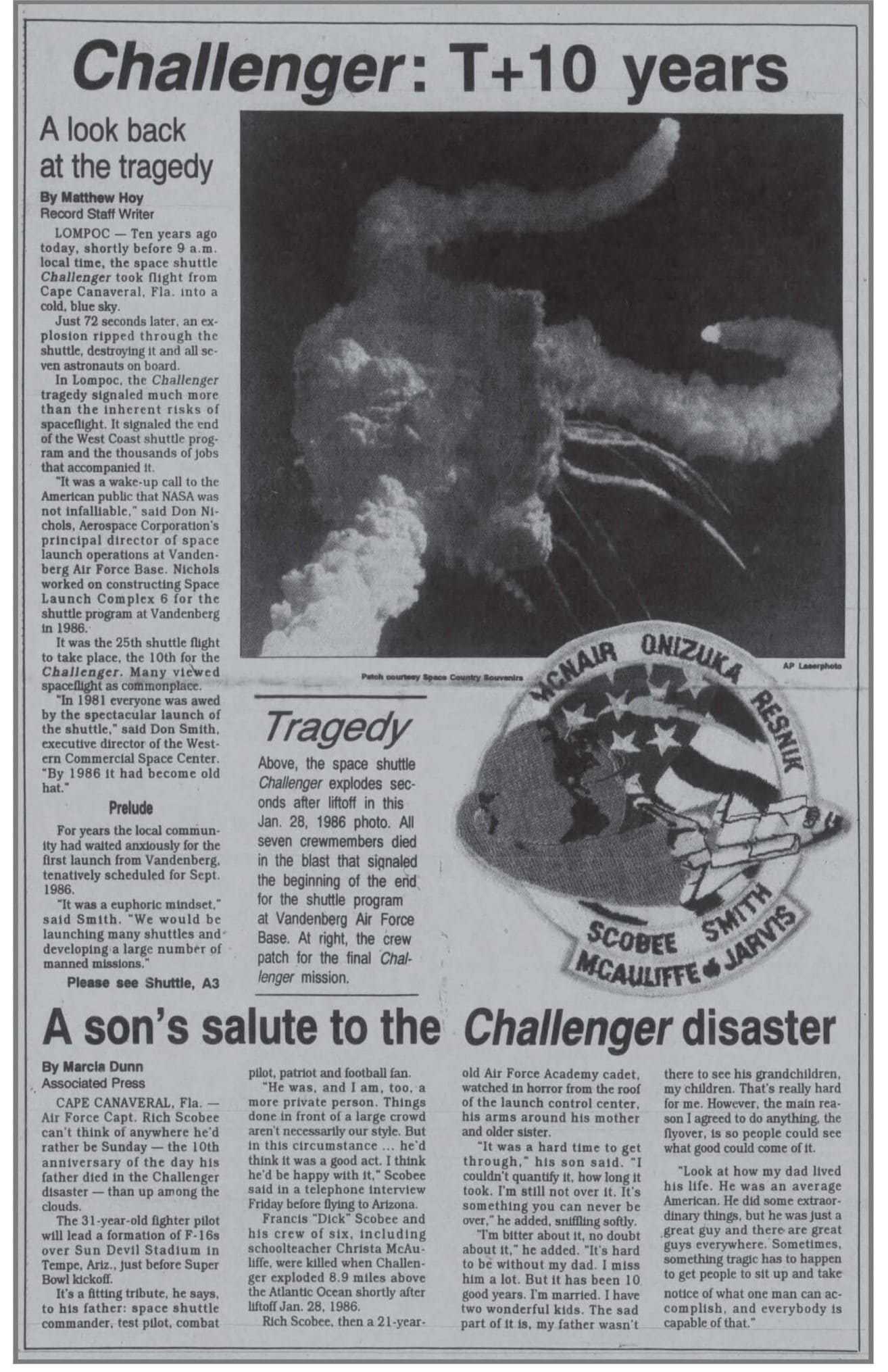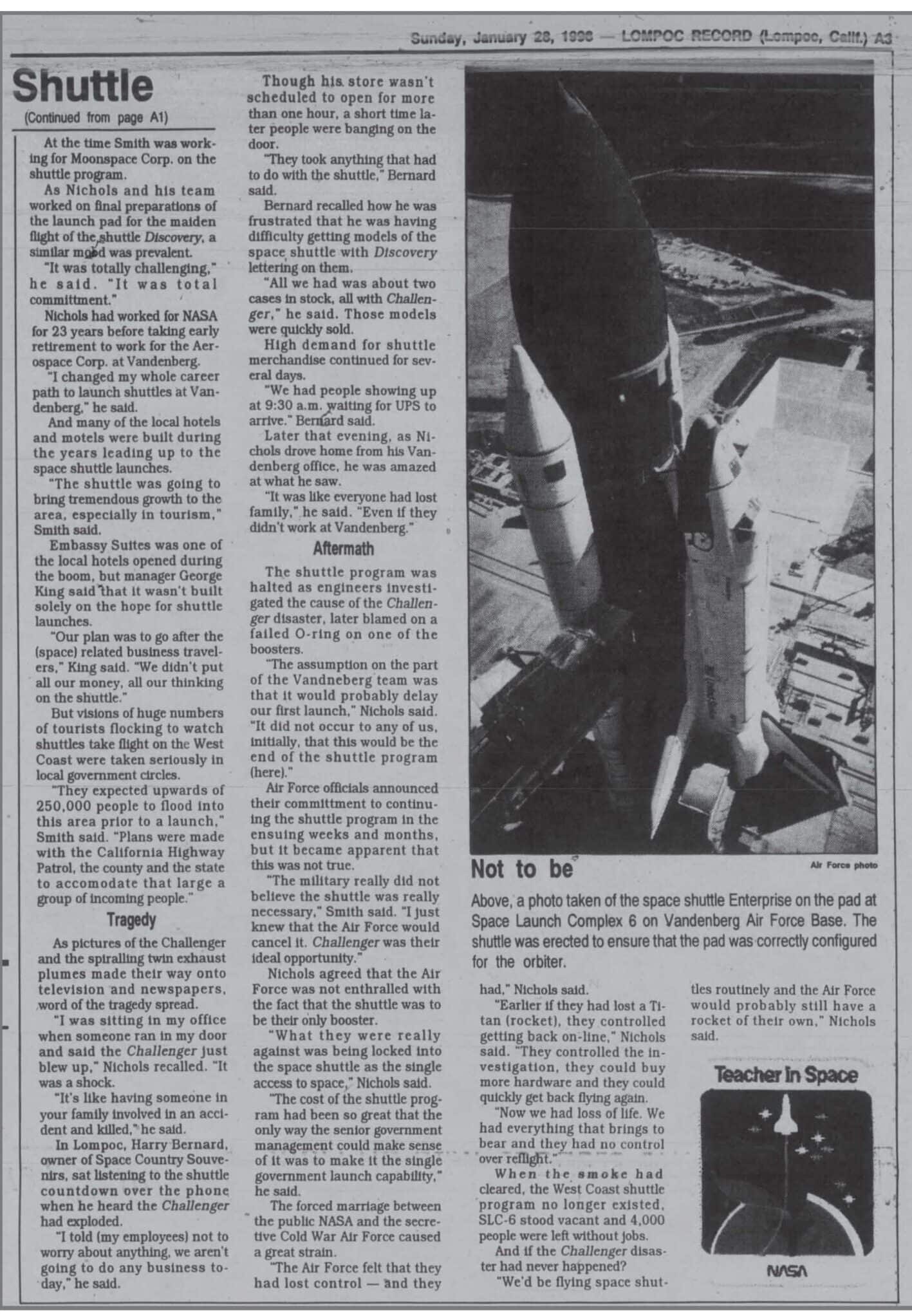By Matthew Hoy
Record Staff Writer
LOMPOC—Ten years ago today, shortly before 9 a.m. local time, the space shuttle Challenger took flight from Cape Canaveral, Fla., into a cold, blue sky.
Just 72 seconds later, an explosion ripped through the shuttle, destroying it and all seven astronauts on board.
ln Lompoc. the Challenger tragedy signaled much more than the inherent risks of spaceflight. It signaled the end of the West Coast shuttle program and the thousands of jobs that accompanied it.
"It was a wake-up call to the American public that NASA was not infalllable," said Don Nichols, Aerospace Corporation's principal director of space launch operations at Vandenberg Air Force Base. Nichols worked on constructing Space Launch Complex 6 for the shuttle program at Vandenberg in 1986.
It was the 25th shuttle flight to take place, the 10th for the Challenger. Many viewed spaceflight as commonplace.
"In 1981 everyone was awed by the spectacular launch of the shuttle," said Don Smith, executive director of the Western Commercial Space Center. "By 1986 it had become old hat."
For years the local community had waited anxiously for the first launch from Vandenberg, tentatively scheduled for Sept. 1986.
"It was a euphoric mindset," said Smith. "We would be launching many shuttles and developing a large number of manned missions."
At the time Smith was working for Moonspace Corp. on the shuttle program.
As Nichols and his team worked on final preparations of the launch pad for the maiden flight of the shuttle Discovery, a similar mood was prevalent.
"It was totally challenging," be said. "It was total commitment."
Nichols had worked for NASA for 23 years before taking early retirement to work for the Aerospace Corp. at Vandenberg.
"I changed my whole career path to launch shuttles at Vandenberg," he said.
And many of the local hotels and motels were built during the years leading up to the space shuttle launches.
"The shuttle was going to bring tremendous growth to the area, especially lo tourism," Smith said.
Embassy Suites was one of the local hotels opened during the boom, but manager George King said that it wasn't built solely on the hope for shuttle launches.
"Our plan was to go after the (space) related business travelers," King said. "We didn't put all our money, all our thinking on the shuttle."
But visions or huge numbers of tourists flocking to watch shuttles take flight on the West Coast were taken seriously in local government circles.
"They expected upwards of 250,000 people to flood into this area prior to a launch," Smith said. "Plans were made with the California Highway Patrol, the county and the state to accommodate that large a group of incoming people.
As pictures of the Challenger and the spiraling twin exhaust plumes made their way onto television and newspapers, word of the tragedy spread.
"I was sitting in my office when someone ran in my door and said the Challenger just blew up," Nichols recalled. "It was a shock.
"It's like having someone in your family involved in an accident and killed," he said.
In Lompoc, Harry Bernard, owner of Space Country Souvenirs, sat listening to the shuttle countdown over the phone when be heard the Challenger had exploded.
"I told (my employees) not to worry about anything, we aren't going to do any business today," he said.
Though his store wasn't scheduled to open for more than one hour, a short time later people were banging on the
door.
"They took anything that bad to do with the shuttle," Bernard said.
Bernard recalled how he was frustrated that he was having difficulty getting models of the space, shuttle with Discovery lettering on them.
"All we bad was about two cases in stock, all with Challenger," he said. Those models were quickly sold.
High demand for shuttle merchandise continued for several days.
"We had people showing up al 9:30 a.m. waitng for UPS to arrive," Bernard said.
Later that evening, as Nichols drove home from his Vandenberg office, he was amazed at what he saw.
"It was like everyone had lost family," he said. "Even if they didn't work at Vandenberg."
The shuttle program was halted as engineers investigated the cause of the Challenger disaster, later blamed on a failed O-ring on one of the boosters.
"The assumption on the part of the Vandenberg team was that it would probably delay our first launch." Nichols said. "It did not occur to any of us, initially, that this would be the end of the shuttle program (here)."
Air Force officials announced their commitment to continuing the shuttle program in the ensuing weeks and months, but it became apparent that this was not true.
"The military really did not believe the shuttle was really necessary," Smith said. "I just knew that the Air Force would cancel it. Challenger was their ideal opportunity."
Nichols agreed that the Air Force was not enthralled with the fact that the shuttle was to be their only booster.
"What they were really against was being locked into the space shuttle as the single access to space," Nichols said.
"The cost of the shuttle program had been so great that the only way the senior government management could make sense of it was to make it the single government launch capability," he said.
The forced marriage between the public NASA and the secretive Cold War Air Force caused a great strain.
"The Air Force felt that they had lost control—and they had," Nichols said.
"Earlier if they had lost a Titan (rocket), they controlled getting back on-line," Nichols said. "They controlled the investigation, they could buy more hardware, and they could quickly get back flying again.
"Now we had loss of life. We had everything that brings to bear and they had no control over rcflight."
When the smoke had cleared, the West Coast shuttle program no longer existed, SLC-6 stood vacant and 4,000 people were left without jobs.
And If the Challenger disaster had never happened?
"We'd be flying space shuttles routinely and the Air Force would probably still have a rocket of their own." Nichols said.
Published Sunday, Jan. 28, 1996, The Lompoc Record.

